You are using an out of date browser. It may not display this or other websites correctly.
You should upgrade or use an alternative browser.
You should upgrade or use an alternative browser.
Paphiopedilum gratixianum
- Thread starter Brabantia
- Start date

Help Support Slippertalk Orchid Forum:
This site may earn a commission from merchant affiliate
links, including eBay, Amazon, and others.
JeanLux
Well-Known Member
Not sure for gratrix.; mine has much more greenish coloration on the dorsal, and the petals are clearly divided conc. color: the upper half more brownish, the lower more greenish!? Jean
Jean, I understand your doubts...but I compared this photo with others in the net and eventually I think this flower is within the variation of the species. Even the staminode looks gratrix like...but to say it frankly - I'm no taxonomist.Not sure for gratrix.; mine has much more greenish coloration on the dorsal, and the petals are clearly divided conc. color: the upper half more brownish, the lower more greenish!? Jean
At least a lovely flower.



SlipperKing
Madd Virologist
Mutant posted one back in Aug that looks very similar
http://www.slippertalk.com/forum/showthread.php?t=26685
Carsten said "Looks like var. daoense to me. Very nice, indeed."
So what does a daoense variety look like?
http://www.slippertalk.com/forum/showthread.php?t=26685
Carsten said "Looks like var. daoense to me. Very nice, indeed."
So what does a daoense variety look like?
SlipperFan
Addicted
Lovely dorsal spotting.
E
Eric Muehlbauer
Guest
Can you show us the whole plant? If the leaves are wide, it could be the true gratrixianum. Most plants with that name are now considered to be affine.

$12.98
$19.98
Nlife Bring On The Sunshine Graphic Short Sleeves Tees Blouses for Women Tops Sweaters for Women
waltzmart

$11.99 ($1.50 / Fl Oz)
SheaMoisture Bath, Body and Massage Oil Lavender Wild Orchid Calming Moisturizer for Sensitive Skin 8 oz
Amazon.com

$19.88 ($0.25 / Fl Oz)
$23.96 ($0.30 / Fl Oz)
Caress Body Wash for Women, Black Orchid & Patchouli Oil, Relaxing, Fragrant Shower Gel to Relax and Recharge, 20 fl oz, 4 Pack
Amazon.com

$45.20 ($45.20 / Count)
$49.89 ($49.89 / Count)
hypehouse Allen + roth 8 in. Orchid Pot with Saucer White
Low Price Home Goods

$27.99 ($0.83 / Fl Oz)
$42.00 ($1.24 / Fl Oz)
Biolage Color Last Shampoo | Helps Maintain Vibrant Color | For Color-Treated Hair | Paraben & Silicone-Free | Vegan | Cruelty Free | 33.8 Fl. Oz
Amazon.com

$35.20
$44.00
Understanding Orchids: An Uncomplicated Guide to Growing the World's Most Exotic Plants
Amazon.com

$27.99 ($0.03 / Count)
$39.99 ($0.04 / Count)
Spa Gifts for Women, Gift Set for Women Enchanted Orchid Scent, Home Spa Kit with Bubble Bath, Body Lotion, Bath Bomb, Bath Salt, Spa Gift Baskets for Women, Birthday Gifts for Women
ArioseMonde Products

$6.00 ($0.30 / Fl Oz)
NIVEA Delicate Orchid and Amber Body Wash with Nourishing Serum, 20 Fl Oz Bottle
Amazon.com

$29.99 ($29.99 / Count)
$32.99 ($32.99 / Count)
Spa Gift Basket, Orchid Jasmine Spa Basket bath and body gift basket with Shower Gel, Bath Bomb, Bath Salts, Jojoba Oil & Lip Balm, Birthday Holiday Home Spa Gifts for Women & Men Fathers Mother day
hailida

$11.99 ($0.12 / Count)
CHUXAY GARDEN Cypripedioideae-Lady's Slipper Orchids,Lady Slipper Orchids 100 Seeds Tropical Exotic Orchids Rare Small Orchid
color green

$50.00 ($5.88 / Fl Oz)
Magnolia Orchid Collagen Age Signature Jelly Mask for All Skin Types, 8.5 Fl Oz/250 ml
BBCV

$13.99 ($2.80 / Count)
$17.49 ($3.50 / Count)
Utopia Home - Plant Pots Indoor with Drainage - 7/6.6/6/5.3/4.8 Inches Flower Pots for Indoor Planter - 5 Pack Plastic Planters - Ideal for Stocking Stuffers or Home Christmas Decorations - White
Utopia Deals

$19.43
$22.95
The Orchid Whisperer: Expert Secrets for Growing Beautiful Orchids (-)
Amazon.com

$58.00 ($6.82 / Fl Oz)
Magnolia Orchid Collagen Facial Hydrating Gel Cream (Upgraded Version) for All Skin Types, 8.5 Fl Oz/250 ml
Do My Best Store

$10.22
$10.99
Orchid Basics: Hints, tips & techniques to growing orchids with confidence
Amazon.com
I have a 'Wedgewood' x 'Lula Girl' just about to open and the bud looks much, much darker than this bloom would have been in bud. Perhaps mine plant isn't a gratrix?
It has a villosum 'stance' to it, I think.
I got one with a similar flower from O&M, as villosum var. Na Thrang.
Check this old thread:
http://www.slippertalk.com/forum/showthread.php?t=6516
Brabantia, what are the leaves of yours looking like?
Check this old thread:
http://www.slippertalk.com/forum/showthread.php?t=6516
Brabantia, what are the leaves of yours looking like?
B
biothanasis
Guest
Lovely flower whatever it is!
It looks gratrixianum-ish..!
It looks gratrixianum-ish..!
- Joined
- Dec 16, 2009
- Messages
- 4,047
- Reaction score
- 4,959
I think its a hybrid. I have similar to this one but I bougth as a cultivated hybrid (no name)
Rick
Well-Known Member
Can you show us the whole plant? If the leaves are wide, it could be the true gratrixianum. Most plants with that name are now considered to be affine.
Correct. This classification was recently reinforced (again) with Koopowitz's new checklist in OD.
I don't think this is totally out of range for flowers labeled as gratrixianum that should be the Vietnamese affine.
But typically there is a pretty distinct stripe through the middle of the petals, and the upper half of the petals are darker than the lower half.
Maybe the Laotian "true" gratrixianum lack that striping (as well as having bigger/wider leaves).
The dorsal doesn't look like the bulk of boxalli that have been floating around.
As more of SE Asia gets explored/exploited we tend to see that every new valley and ridge has its own subtle variety of villosum/gratrixianum/insigne/affine. I have a power point presentation by Averyanov that would put all these concepts into a single huge very smeary species concept.
The Mutant
Well-Known Member
Yup, it looks very similar indeed and mine also came from O&M, but mine was labeled as "villsoum var. gratrixianum", which, as far as I've understood it, was the old name for gratrixianum.Mutant posted one back in Aug that looks very similar
http://www.slippertalk.com/forum/showthread.php?t=26685
Carsten said "Looks like var. daoense to me. Very nice, indeed."
So what does a daoense variety look like?
The leaves on my gratrixinaum are 4 cm wide and have purple spotting on their bases. I don't know if mine is a "true" gratrixianum or "just" one of the variants of this rather murky bunch of Paphs (villosum, insigne, affine etc.), but I really like mine and it seems to be a vigorous grower as well so it's a keeper.
Some time ago O&M got some plants from this species group like gratrixianum, villosum... Sometimes after repotting, tags were changed unwittingly are customers change plants during saerching the batches. I also bought some plants labeled as gratrixianum daoense. They turned out to be gratrixianum i think:
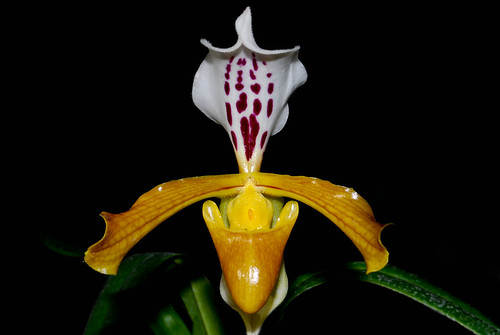
Paphiopedilum gratrixianum 'daoense' von epicphals auf Flickr
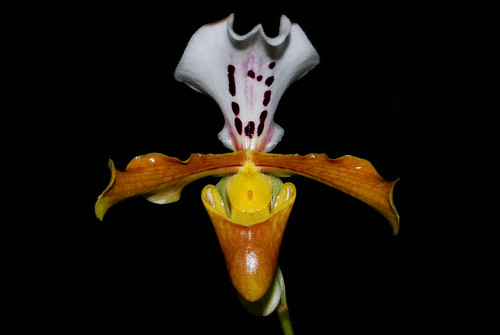
Paphiopedilum gratrixianum 'daoense' von epicphals auf Flickr
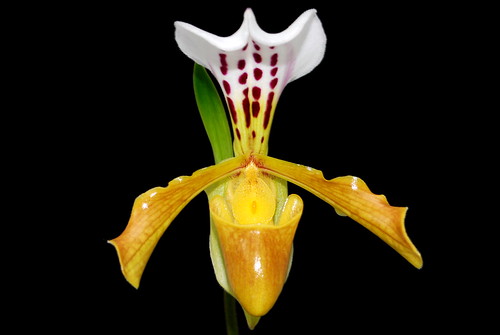
Paphiopedilum gratrixianum var. daoense von epicphals auf Flickr
here is another old photo of a plant which was in bloom within thius batch:
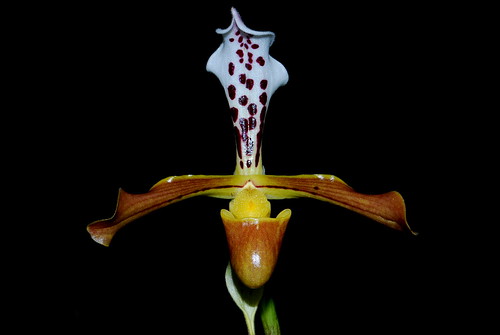
O&M 0810 Paphiopedilum species von epicphals auf Flickr
and the flowering batch together with P. coccineum in 2009:
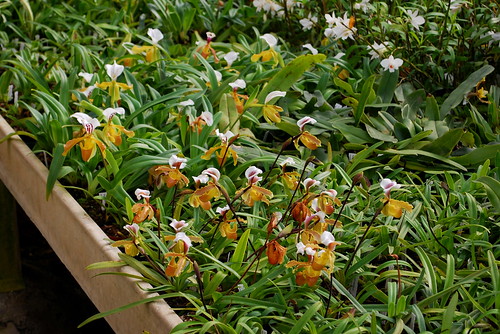
O&M 1009 Paphiopedilum barbigerum var lockianum & gratrixianum von epicphals auf Flickr

Paphiopedilum gratrixianum 'daoense' von epicphals auf Flickr

Paphiopedilum gratrixianum 'daoense' von epicphals auf Flickr

Paphiopedilum gratrixianum var. daoense von epicphals auf Flickr
here is another old photo of a plant which was in bloom within thius batch:

O&M 0810 Paphiopedilum species von epicphals auf Flickr
and the flowering batch together with P. coccineum in 2009:

O&M 1009 Paphiopedilum barbigerum var lockianum & gratrixianum von epicphals auf Flickr
SlipperFan
Addicted
I'd pick the second one up in a heartbeat!
The Mutant
Well-Known Member
It looks a lot like my gratrixianum except that the leaves are a bit shorter on mine (longest is 20 cm) and wider (3.8 cm, I got a bit carried away when I wrote 4 cm).
quietaustralian
Well-Known Member
Correct. This classification was recently reinforced (again) with Koopowitz's new checklist in OD.
I don't think this is totally out of range for flowers labeled as gratrixianum that should be the Vietnamese affine.
But typically there is a pretty distinct stripe through the middle of the petals, and the upper half of the petals are darker than the lower half.
Maybe the Laotian "true" gratrixianum lack that striping (as well as having bigger/wider leaves).
The dorsal doesn't look like the bulk of boxalli that have been floating around.
As more of SE Asia gets explored/exploited we tend to see that every new valley and ridge has its own subtle variety of villosum/gratrixianum/insigne/affine. I have a power point presentation by Averyanov that would put all these concepts into a single huge very smeary species concept.
I thought the P affine debate was over?
Xavier translated the original description of P affine and I asked Dr Braem to confirm a few weeks ago. The translation I received via Dr Braem relating to leaves is.
"Leaves 4 to 5, more or less lobed, up to 15 cm long and up to 3 cm wide, more or less dark green with white margins, striped and spotted with darker green, acute at the tip, 3-dented, distinctly keeled on the under side."
It appears that P affine was a mottle leaved Paph with a "villosum" type flower. This is what one would expect from a natural hybrid of Paph. villosum and Paph. appletonianum or as the natural hybrid of these two species is known, Paphiopedilum x cribbii.
Similar threads
- Replies
- 12
- Views
- 849





























